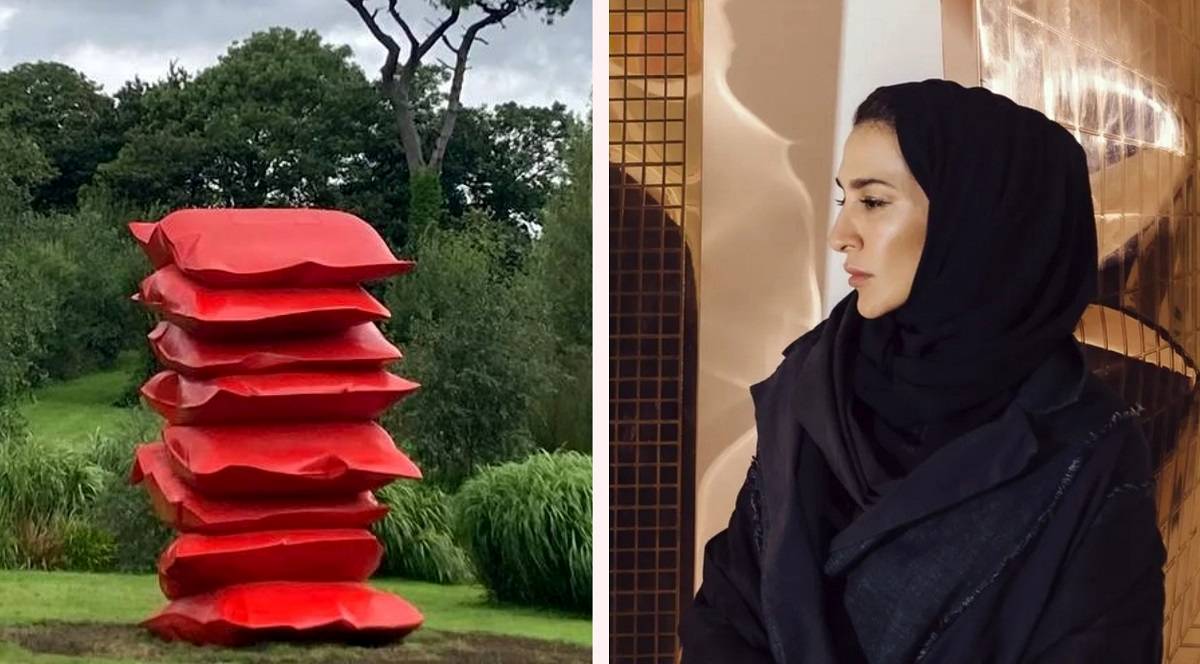
Shaikha Al Mazrou's sculpture heads to medieval gardens in the UK's Cornwall
After being displayed at Frieze London, the towering work has arrived in the British seaside county.
Artdayme: In a far-off vista in the UK's Cornwall, fluffy pillows are piled high on top of one another making a four-metre-tall stack. Though it seems precarious, the blustery Cornish wind doesn’t ruffle any fabric or dislodge any cushions.
As aficionados of Shaikha Al Mazrou’s art might have guessed, the work is an illusion. The stack is made of fibreglass and resin, secured by an internal steel armature, and has been confounding and delighting visitors to Cornwall since it arrived late last month.
:quality(70):focal(2057x2050:2067x2060)/cloudfront-eu-central-1.images.arcpublishing.com/thenational/6XAD5NF575A2FCXV4VBTA3TTNM.jpg)
Shaikha Al Mazrou's work in Tremenheere Sculpture Gardens, Cornwall, UK. Photo: Tremenheere Sculpture Gardens
Red Stack first appeared at Frieze Sculpture last year, the public exhibition of artworks that the Frieze fair hosts in Regent’s Park, London. It is the largest sculpture that Dubai artist Al Mazrou, who teaches at NYU Abu Dhabi, has made, and her second major foray into public artwork.
Since then, Red Stack has travelled 482km to the south-western tip of the UK, where it has now taken pride of place in the idiosyncratic, thoughtfully arrayed grounds of the Tremenheere Sculpture Gardens.
:quality(70)/cloudfront-eu-central-1.images.arcpublishing.com/thenational/YWRVLNVFPJDGTPGGNIC2MQS2XA.jpg)
Tremenheere Sculpture Gardens with a view on to the island of St Michael's Mount, which houses a medieval castle and monastery. Photo: Tremenheere Sculpture Gardens
Tremenheere's history dates back to the medieval ages, when it was owned by the monks who lived on the nearby island of St Michael’s Mount. The order sold the grounds in 1295 to the farmer Michael De Tremenheere, whose family lived on the land for 600 years and planted trees such as beech, oak, sweet chestnut and holly.
In 1997, Irish doctor Neil Armstrong and his wife, Jane Martin, became the third owners of the site, transforming it into a sculpture park and cultural centre. They built a cafe and a gallery, and now host rotating exhibitions as well as works by artists such as James Turrell, Richard Long, David Nash and Dorothy Cross.
Unlike most sculpture parks, however, the landscape and the art are given equal attention. Armstrong collects both art and vulnerable and disparate seeds and varietals. The two elements have to work together, he says – making the commissioning process an active negotiation.
“The artists have to earn their place – they can't just turn up and flounce around,” says Armstrong, who grew up on a farm in Ireland before heading to boarding school. “They have to bring something to the party. Their work has to embellish and work with what's around them. It may be something whimsical, something profound, or a directional prompt – but not just showing work for the sake of it. It has to fulfil this criterion of being in some sort of collusion with the landscape.”
:quality(70)/cloudfront-eu-central-1.images.arcpublishing.com/thenational/7547FH3D5RF4DBA4KFXVOFBWBA.jpg)
Richard Long's Tremenheere Line (2013). Photo: Tremenheere Sculpture Gardens
The collaborative ethos has resulted in works that often wonderfully deviate from established series. The British land artist Richard Long, for example, made one of his well-known “lines” in the gardens. Unlike his renowned A Line Made by Walking (1967), for which Long flattened out a line on a field in Wiltshire, the Tremenheere line exists in positive space: in which he planted a sequence of tall flowering grass, allowing the work to grow organically.
Armstrong was lucky to work early on with one of the pioneers of Land Art, US artist James Turrell. In 1999, Turrell was looking for a place to observe the solar eclipse, and Tremenheere happens to sit on the eclipse's centre line.
“It was pure serendipity,” Armstrong recalls.
Turrell created a domed space in which one could observe the solar phenomenon, which remained at Tremenheere for three months. By the time it opened, the pair had hit it off, and Turrell agreed to make a permanent work for the little-known gardens.
He ended up creating two: Skyspaces – a series of chambers with an aperture in the ceiling opening out to the sky – and Aqua Oscura, which is unique in his canon of works. Situated in an underground cistern at the property, Aqua Oscura is constructed as a camera obscura. Light enters the chamber through a pinhole aperture, falling on a mirror below that redirects the beam at a 45-degree angle on to a wall of the underground tank.
:quality(70)/cloudfront-eu-central-1.images.arcpublishing.com/thenational/D3VWBBWRMBE4PNFGH6LK7P3A7Y.jpeg)
A long-exposure photograph of the image produced by James Turrell's Aqua Oscura (2013). Photo: Tremenheere Sculpture Gardens
Though Red Stack was not a Tremenheere commission, Armstrong and his team spent days scouting locations where it would fit. The concerns were partly logistical. Al Mazrou's work is so monumental that it has to be installed on level ground. They also took note of the richness of the colour and the imposing, but familiar, aspect of the stacked pillows. In the end, they chose a high meadow, flanked by open sky and bright greenery.
It will remain in situ for at least a year, before travelling onwards again. Tremenheere operates with no external funding, and Al Mazrou's work is only there until it finds a permanent buyer.
"In some ways, it's good that things go, because it leaves room for something else," says Armstrong. "I don't want to be a museum and that's one of the reasons why I only work with living artists.
“I'm not really in the art world, I slipped somewhere in the ether," he says. "I don't have any professional training. I don't interact with any of the grand institutions. I'm free of all that. And I think that's really good. I’m in the art world in the sense that I'm just like everyone else walking down the street, who can have a look and decide what they think.”

LEAVE A RELPY